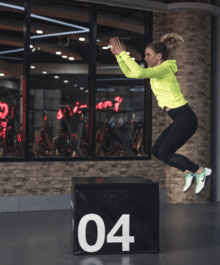Power training
Power training typically involves exercises which apply the maximum amount of force as fast as possible; on the basis that strength + speed = power.[1] Jumping with weights or throwing weights are two examples of power training exercises. Regular weight training exercises such as the clean and jerk and power clean may also be considered as being power training exercises due to the explosive speed required to complete the lifts. Power training may also involve contrasting exercises such as heavy lifts and plyometrics, known as complex training, in an attempt to combine the maximal lifting exertions with dynamic movements. This combination of a high strength exercise with a high speed exercise may lead to an increased ability to apply power. Power training frequently specifically utilises two physiological processes which increase in conjunction with one another during exercise. These are deep breathing, which results in increased intra-abdominal pressure; and post-activation potentation, which is the enhanced activation of the nervous system and increased muscle fibre recruitment. Power training programmes may be shaped to increase the trainee's ability to apply power in general, to meet sports specific criteria, or both.
Specific forms of power training
There are various forms of power training which may be used singularly or in combination with one another.
Plyometrics and loaded plyometrics
Plyometric training typically involves jumping exercises; these exercises may begin from the feet only or also involve taking off from the hands such as is found in a plyometric push up. Plyometric may also refer to exercises which involve similar quick movements of the body in a repetitive manner, such as repeatedly throwing a medicine ball in the air, catching it, and throwing it up again and so forth. Usually, an exercise is considered plyometric or not based upon its speed, the rapidity of its repetitions, and the extent to which it utilises the body's stretch-shortening cycle. This cycle is where a muscle may be considered to alternately lengthen (an eccentric action) and then shorten (a concentric action) in quick succession during a repetition. The performance of repetitive jumps and sprinting both clearly emphasise the stretch shortening cycle.[2]
Loaded plyometrics refers to the addition of a load, or weight, to jumping exercises. Jumping up and down with a trap bar for instance, or with a barbell held over the head. Loaded plyometrics may increase explosive power more so than unloaded plyometrics.[3] Two people can also co-operate in order to perform loaded plyometric exercises. For example, one person can carry the other on their back while they jump or hop.
Ballistic training
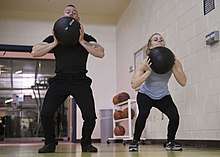
Ballistic training is based upon maximising the acceleration phase of an object and minimising the deceleration phase. This may involve throwing a weight, as the term ballistic implies, but may also involve jumping whilst holding a weight or swinging a weight. Examples include throwing a medicine ball, jumping with a trap bar, or swinging a weighted club.[4]
Complex training
Complex training, sometimes referred to as contrast training, involves alternating heavy lifts with plyometric exercises. Ideally, the exercises should move through similar ranges of motion. For example, a set of back squats at about 85-95% 1RM followed by a set of vertical jumps. The intention is to utilise the PAP effect from the heavy back squats in the jumping exercises and thereby increase the power with which the jumps are performed with.[5] Over a period of training, this may increase the trainee's ability to perform the plyometric exercise more powerfully without the preceding heavy lift being required.
Contrast loading
Contrast loading involves the alternation of heavy and light loads in weight training exercises. The light lifts should be considerably lighter than the heavy lifts. For example, a bench press exercise at about 85-95% 1RM followed by a set at about 30-60% 1RM. The heavy lifts should be performed fast with the lighter lifts being performed as fast as possible. The joints should not be locked as this inhibits muscle fibre recruitment and reduces the speed at which the exercise can be performed. Weighted jumps or a throwing exercise may take the place of the lighter lifts.[6]
Explosive power lifts
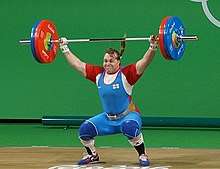
Explosive power lifts are weight training exercises which require a very fast movement to be performed by the lifter in order to lift the weight. For instance, in a power clean, a barbell is quickly lifted from the floor and unto the upper chest; this must be performed fast in one dynamic movement otherwise it would not be possible to move the weight to this position. Similarly, in a clean and jerk, a lifter moves a barbell to a position above their head whilst they quickly lower their height to allow for the easier extension of their arms; this movement must be performed in one very quick fluid action. If the lifter attempted to press the weight above their head slowly then they would not be able to. It is the dramatic increase in speed which allows for the lift to be completed and it is therefore an essential component.
Gymnastics
.jpg)
Gymnastic exercises may be considered as being calisthenic in nature with a particular focus on achieving high levels of speed, rhythm and co-ordination. In addition to developing overall power and endurance, they are excellent for developing the strength and mobility of the core and joints. In a study of the power output of gymnasts, Monem Jemni attests that the high peak-power outputs gymnasts are capable of place them near the top level for power athletes; notably, higher than elite level wrestlers.[7] Gymnastic exercises include the pommel horse, rings, parallel bars, vaulting with the use of apparatus, and various forms of dance and somersaults.
Sprint training
Sprint training is usually meant in regard to running but may also include cycling or swimming. It is an effective means of training the body to be able to perform faster for longer. As well as increasing technical proficiency in that form of sprint, it also develops overall power, cardiovascular capacity, and muscular endurance. The benefits of sprint training in terms of developing a greater power output can therefore help in the performance of other explosive power movements.[8] It will usually be included in any comprehensive power training regime.
- Examples of sprinting
 Swimming
Swimming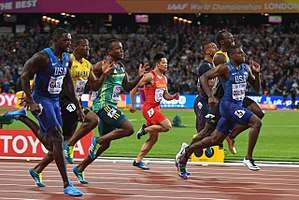 Running
Running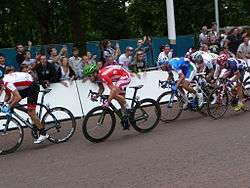 Cycling
Cycling Rowing
Rowing
Related physiological processes
Deep breathing and intra-abdominal pressure
During exercise a person breathes deeper in order to meet higher oxygen requirements. This adoption of a deeper breathing pattern also serves a secondary function of strengthening the core of the body. This strengthening effect occurs because the thoracic diaphragm adopts a lower position than it does than when at rest; this generates increased intra-abdominal pressure which helps to strengthen the lumbar spine and the core of the body overall.[9] For this reason, taking a deep breath, or adopting a deeper breathing pattern, is a fundamental requirement when lifting heavy weights.
Post-activation potentiation (PAP)
The term post-activation potentiation is used to describe the increased performance or power output after performing a strength exercise.[5]
During exercise the nervous system becomes increasingly active and an increased number of muscle fibres are recruited in order to aid the performance of the exercise. This effect is especially apparent during the lifting of heavy weights. Subsequently, to the performance of the exercise, the increased nervous system activation and recruitment of muscle fibres continues for a period of time; this is referred to as post-activation potentiation, or the PAP effect, and may lead to an increased ability to apply power.[10] For example, if a light weight is lifted, and then a heavy weight is lifted, and then the same light weight is lifted again, then the light weight will feel lighter the second time it is lifted; this is due to the PAP effect from the heavy lift. In complex training the PAP effect may be used to perform plyometric exercises more powerfully, or in contrast loading to perform resistance based exercises more powerfully. Ultimately, the usage of it in a training regime is to condition the trainee to perform with a heightened nervous system activation and increased muscle fibre recruitment; thereby resulting in the ability to move more powerfully as a standard.
Universal elements of power training
Core strength
The body's core, sometimes referred to as the torso, helps all other movements of the body. In power movements this is especially the case as the core musculature is increasingly recruited in order to provide additional power. A stronger core also improves a person's ability to balance. The most effective core strength training involves all parts of the core being strengthed. This may involve bending and straightening in all directions (flexing and extending), circular movements (rotation and circumduction), and holding isometric poses. Additional resistance may be added as required. Generally, the more comprehensive the training is the greater the benefits to a person's ability to apply power; notably, this is partially due to avoiding the problem of disproportionately weak core muscles hindering the power output of strong core muscles that they are working in conjunction with.[11]
Joint strength
A large amount of power can only be applied if the joints are strong enough to be able to cope with it and transfer it. If a joint is too weak then the power that can be applied by and through that joint is necessarily limited.[12] This is especially the case in dynamic movements which require the rapid application of force to an external object and the absorption of impact forces by the body. For instance, a sprinter must have strong ankle joints in order for their foot to be able to apply leverage and transfer force to the ground, and also to help to absorb any impact forces when the foot is placed. Due to the requirements of any given stride, the ankle must be strengthened in all ranges of movement, including twisting. This can be achieved by hopping up and landing facing a different direction for example. A boxer would also need strong ankles but they would also have the added requirement of strong wrists in order to be able to transfer the power of their body adequately to their fists and hence to the target. An example of a wrist strengthening exercise is a one-handed barbell deadlift exercise, which requires increased utilisation of the wrist in order to stabilise the bar. Strong and flexible joints also help to prevent injury.
Proportions of strength

The body most efficiently produces power when its strength producing areas exist in particular proportions. If these proportions exist in the correct ratio to each other, then power generation can be optimised. Conversely, if one area is too strong, this may mean that it is disproportionately strong relative to other areas of the body. This may cause a number of problems: a weaker area of the body may be excessively strained by working in conjunction with the stronger area; and the stronger area may be slowed by working with the weaker area. Such problems hinder power development.
The optimum proportions of strength for power generation may be non-sports specific and based upon an ability to perform more powerfully in general, or sports specific and based upon the requirements of a particular sport. For example, a sprint cyclist may incorporate heavy back squats into their training regime in order to increase their leg strength, which can in turn help them to generate more power on the bike. However, this may lead to excessive leg strength being developed relative to their core strength. This may hinder any improvement to performance and increase the risk of injury. As such, they may incorporate forms of core training which helps them to perform their back squat more efficiently and reduce the risk of injury. The improved performance of the back squat would also mean it was more beneficial to the cycling action.[13] In such examples the performance of the specific sport or exercise can be improved by ensuring that the involved areas of the body are trained to be in particular proportions of strength, as considered relatively to each other. It is notable that the performance of the sport or exercise alone does not necessarily lead to the body developing in its optimum proportions of strength in order to perform them more powerfully. As stated previously, this result is achieved with the aid of supplementary exercises which optimally influence the body's proportions of strength so a more powerful performance can be achieved.
Isometric presses and explosive power movements
Immediately prior to performing a powerful movement the body instinctively performs an isometric preload: this generates force in the muscles which adds to the power of the subsequent dynamic movement. A fundamental element of this preloading is an isometric press action. An everyday example is when a person gets up off a chair. The person raises their posterior off the chair and forms an isometric press, involving the downward force of their torso onto their bent legs, which push upwards with an equal amount of force. From this point the person then stands up. The isometric press which was generated by the torso and the legs helped them to preload their muscles so as to aid the subsequent move to stand up fully. A more dynamic example of this process can be found in a vertical jump. In this case, the jumper crouches down, generates an isometric press involving the downward force of their torso and the upward force of their bent legs, before powering upwards into the jump.[14] Isometric presses may also be adapted to suit sports specific requirements, such as in boxing. Here, a boxer may position their bodyweight primarily over their bent lead leg before throwing a lead hook. The force generated by the isometric press, involving the downward force of the torso and the upward force of the lead leg, is channelled into the subsequent punch making it more powerful.[15] In athletic events such as sprinting, deliberate apparatus, called starting blocks, are used so the sprinters can perform a more powerful isometric press and channel this additional power into their first strides forwards: this ability to perform an enhanced isometric press allows them to start faster. Isometric presses may be performed faster or slower and in a variety of different ways but all perform the same role of isometrically preloading the muscles so a subsequent dynamic movement can be performed more powerfully. For this reason, isometric presses feature strongly in sports and athletics. The force they can generate can be increased and their instinctive use can be encouraged through the training of the respective actions required to form them (e.g. knee raises, sit-ups, squats, jumps) and the associated musculature (e.g. glutes, thighs, hamstrings, core). In terms of a person's direct utilisation of isometric presses as a power generation method, this is achieved as part of their instinctive and intuitive performance of isometric preloads, and their further deliberate intensification of them.
- Examples of isometric presses in sport and athletics
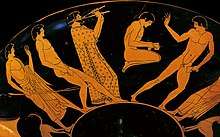 The jumper on the left performs a distinctive isometric press, primarily by applying downward pressure onto his bent rear leg. This acts as a means of preloading the muscles prior to engaging in a jump from standing. The jumper to the right of him is mid-flight.
The jumper on the left performs a distinctive isometric press, primarily by applying downward pressure onto his bent rear leg. This acts as a means of preloading the muscles prior to engaging in a jump from standing. The jumper to the right of him is mid-flight..jpg) Olympian Ryan Lochte (near) standing on top of the wedged starting blocks. Each swimmer performs a preparatory isometric press by applying downward pressure onto their bent legs. This serves to preload the muscles and helps to make the subsequent dive more powerful.
Olympian Ryan Lochte (near) standing on top of the wedged starting blocks. Each swimmer performs a preparatory isometric press by applying downward pressure onto their bent legs. This serves to preload the muscles and helps to make the subsequent dive more powerful. Sprinters using starting blocks to help them to perform an enhanced isometric press. The additional force generated by the presses will be channeled into their initial strides and allow them to start faster.
Sprinters using starting blocks to help them to perform an enhanced isometric press. The additional force generated by the presses will be channeled into their initial strides and allow them to start faster. Sumo wrestlers just beginning to charge forwards after crouching down and performing an isometric press. The press enables them to charge into their opponent more powerfully, which is especially useful when the match begins.
Sumo wrestlers just beginning to charge forwards after crouching down and performing an isometric press. The press enables them to charge into their opponent more powerfully, which is especially useful when the match begins. American Football players line up against each other and crouch down into an isometric press position. This allows them to rush forwards more powerfully when the play begins; this is particularly useful in regard to tackling or blocking an opponent.
American Football players line up against each other and crouch down into an isometric press position. This allows them to rush forwards more powerfully when the play begins; this is particularly useful in regard to tackling or blocking an opponent. A discus thrower performs an isometric press by applying downward pressure onto his bent right leg. This allows the throw to be performed more powerfully.
A discus thrower performs an isometric press by applying downward pressure onto his bent right leg. This allows the throw to be performed more powerfully..jpg) A shot putter performs an isometric press by applying downward pressure onto his bent right leg. This will allow him to turn and spring forwards more powerfully, and channel the muscular force generated by the press into the throw.
A shot putter performs an isometric press by applying downward pressure onto his bent right leg. This will allow him to turn and spring forwards more powerfully, and channel the muscular force generated by the press into the throw.
The sport of powerlifting
Power training and the sport of powerlifting should be distinguished from one another, although there are some areas where they overlap. Powerlifting, as a sport, is often considered in regard to the three main lifts competitions are judged upon. These are the back squat, the deadlift, and the bench press. These exercises would not ordinarily be considered as power training exercises because they are not usually performed fast enough. The sport of powerlifting acquires its name due to the great amount of force that is required to lift very heavy weights. A major difference between the sport and power training is that in powerlifting competitions it is often required that the joints are locked for a lift to be registered as complete, whereas this would not usually be possible in power training because it would drastically inhibit the dynamic nature of the movements and lead to injury.
Historical examples of power-type training
_mercenary_throwing_the_stone.jpg)
In terms of loaded plyometrics and ballistic training, jumping with weights, either handheld or in the form of armour, and throwing the discus and javelin featured as part of sport and military training regimes in Ancient Greece. Amongst the heaviest known throws in antiquity, was a one handed overhead throw of a stone weighing 140 kg and which had a handle, by the Ancient Greek, Bybon. The record of this throw, which is sometimes translated as a lift, is inscribed onto the stone itself.[16] Throwing a stone was also a popular pastime and military training method in the Medieval ages, with records of it including numerous depictions of a one-handed throw of a stone, roughly the size of a person's head, from the shoulder.
Ancient Persian and Indian wrestlers used to swing heavy wooden clubs, called Meels in Persian, or stone-topped wooden clubs, called Gadas in India, in order to develop power. Notably, such exercises help to build strong and flexible joints.
In a similar vein to contrast loading, the Romans trained with weapons which were double the weight of ordinary weapons, in order that when they used the ordinary weapons they would feel lighter and easier to use.[17]
In terms of heavy lifts, as a test of strength and manhood various societies, such as Celtic and Nordic ones, used to practice stone lifting. This involved lifting very heavy stones, usually over 100 kg, either up to their waist or onto their shoulder. Two examples are the Menzies stone (115 kg) in Scotland or the Husafell Stone (190 kg) in Iceland.
See also
References
- Kent, Michael, 'Power' in Oxford Dictionary of Sports Science & Medicine, Oxford: OUP, 1998
- Kent, Michael, 'Plyometrics' in Oxford Dictionary of Sports Science & Medicine, Oxford: OUP, 1998
- Hansen, Derek, Kennelly, Steve, 'Equipment' in Plyometric Anatomy, Leeds: Human Kinetics, 2017
- Fleck, Steven J. & William J., Kraemer, 'Ballistic Training' in Designing Resistance Training Programmes, Leeds: Human Kinetics, 2013, p.280
- Steven J. Fleck & Kraemer, William J., 'Complex Training, or Contrast Loading' in Designing Resistance Training Programmes, Leeds: Human Kinetics, 2013, p.253
- McGuigan, Mike, 'Contrast Training' in Developing Power, Leeds: Human Kinetics, 2017, pp. 196–197
- Jemni, Monem, 'Power output of gymnasts' in The Science of Gymnastics, London: Routledge, 2011, p.11-12
- Combine Sprints and Weight Training for Accelerated Gains https://breakingmuscle.com/fitness/combine-sprints-and-weight-training-for-accelerated-gains Retrieved 22 August 2019
- "Diaphragm function for core stability » Hans Lindgren DC". hanslindgren.com.
- Steven J. Fleck & Kraemer, William J., ‘Complex Training, or Contrast Loading’ in Designing Resistance Training Programmes, Leeds: Human Kinetics, 2013, p.253
- Contreras, Bret, 'Core' in Bodyweight Strength Training Anatomy, Champaign: Human Kinetics, 2014, pp.55-58
- Imbo, William. "How Flexibility Affects Strength (& Vice Versa) - BoxLife Magazine".
- Newton, Harvey, 'Correct amount of strength' in Explosive Lifting for Sports, Leeds:Human Kinetics, 2010, p.5
- Sharkey, Brian J. & Gaskill, Steven E. 'Preload and Elastic Recoil' in Fitness and Health, Champaign:Human Kinetics, 2007, p.169
- Dempsey, Jack, 'Stance' in Championship Fighting Explosive Punching and Aggressive Defense, 1950
- Sweet, Waldo, Early Sport and Recreation in Ancient Greece: A Sourcebook with Translations, Oxford: OUP, 1987, p.104
- Adkins, Lesley & Adkins, Roy A., Handbook to Life in Ancient Rome, New York: Facts on File, 2004, p.81
